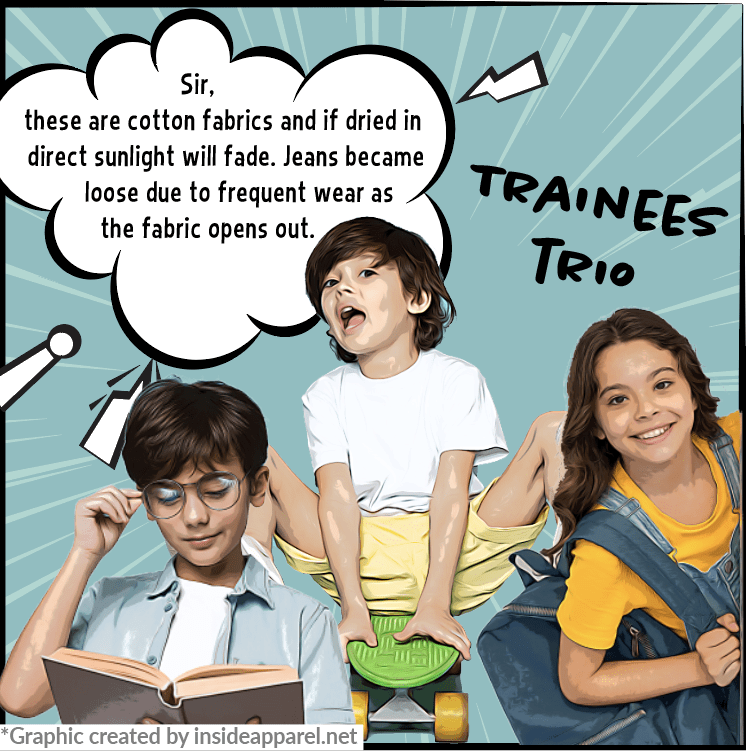Anindya's Anecdotes #3
“Quality” a word that every one in the organisation is scared of! But passionate about…
What does it mean? No one knows.
It's one of the most dynamic words used in the industry, solely defined by the stakeholders perception.
How this quality is understood by all is a mystery to most, a lesson I learnt in my first job.
It started one fine morning, when Mr. Lead M. All, our chairman, walked into the office fuming. He summoned each and every stakeholder to his room. This included the CEO, the merchandising head, the quality head, the product and design teams.
‘Oh! boy’, was it baptism by fire for us young trainee’s who had just joined the company.
As we all filled into the room, we could only see two things;
One, the anger on his face and
Second, the pile of three shirts on his desk…
And suddenly he looked at the quality head and roared;

After a minute of silence, the quality head mustered the courage to ask,
“But what happened?”
“See this,” said the chairman…
Unfolding the shirts one at a time, he pointed to the many issues. A loose button, faded colors, uncut threads and so on. With each issue, his voice got louder and our heads hung lower. And then in an obviously foul mood, he said “I don’t even know why I’ve hired you guys!”
We all slunk out of his room in utter dismay. Everyone huddled around Mr. Qualithello, the head of quality giving him questioning looks, “Who’s the auditor on this? How did he allow this to pass? Does he even know how to check?”
“But we did not come up with the instructions, we just executed them.”, he muttered under his breath.
And then started the “tandav”,




In the meantime, the MR.Qualithello had called the vendor in, who quietly heard us out and then asked for the garments in question. He inspected them and said;
‘These have all been made within specifications, all approvals are in place,’ he said and started showing us the detailed style file maintained by the factory.
Thus the morning passed, with everyone furious and playing the blame game with panache. Tired with the day’s activities and with no solution in sight, everyone decided to pass on the task to the kids in the system, namely us - The Trainees…
We were told to figure out where this problem originated from. With no clue in hand, we turned to the chairman’s secretary.
‘His friend, picked up these pieces from our store, and his driver handed them over in the morning’, she said.
So, in our innocence, we took the friend’s phone number and called him up.
‘The garments have faded, the jeans have become loose and I was wondering if someone could get that button fixed’, he said. On further enquiry we learnt that these garments had been purchased over six months back.

His friend was extremely happy that someone had spoken to him. We also had his clothes ironed and returned to him and the button fixed. His driver came and took the pieces.
In the evening, the chairman, beaming and obviously happy left for the day, breezing past us sharing general pleasantries.
This incident taught a valuable lesson;
‘Quality’ is defined by different stakeholders differently.
For the customer, it is fit, hand-feel, lustre, vibrancy of colour, whether the garment behaves well after multiple wears, no obvious defects like tears, stains etc.
For the designer, it has to be a perfect representation of what’s been conceived in her/his mind. Is the colour matching perfectly, the fit is as per specification given, wash, hand-feel etc., as defined.
For the product merchandising team, it’s about matching what the designer has defined, but with commercial tweaks gleaned from sales feedback.
For the sourcing teams and vendors, it’s about matching expectations, but within cost and given timelines.
It’s the quality team, that has the dirty job of auditing at various stages to ensure the products come out right.
In other words, most of what is understood as quality by the customer is defined by design and product teams and the rest is just about whether those defined parameters have been met in production or not.
Unfortunately, it’s the quality team that takes the brunt of the criticism, the only time someone remembers them is when something has gone wrong. When things go well, everyone else gets the credit. There is very little in quality teams hands,
- they do not make the specifications,
- they don’t select the vendor,
- they don’t close the costs.
They just advise on technical issues and audit, but they are the ones who carry the can every time there is a customer return or complaint.
Most companies do not even realise that a lot of customer complaints are unjustified and happen due to garment mishandling post purchase. And the rest is mostly about fits and aesthetics on which the quality teams do not have a say. But every time the word quality comes up every body looks at the quality team for answers.
This does not mean that they don’t make mistakes. Sometimes they do, then improvement plans and processes should be put in place. But most of our other stakeholders do not realise that a larger aspect of quality as understood by the consumer actually is about how the product has been defined.
So the question, I ask is ‘Who is responsible for quality? The guy’s who define or the guy’s who police?’
I feel we need to approach quality more holistically in an integrated manner where all the stakeholders clearly understand and look at fulfilling consumer expectations rather than, their own narrow definitions of quality. Hence, the truth lies somewhere in between.
Well, what do you think? Let me know your thoughts and experiences on the same.
RELATED TOPICS:#Apparel,Anindya Ray
Leave a comment
Our email address will not be published. Required fields are marked *







4 Comments
MatatroffJan 20, 2023 at 04:07 am
2015 Apr 21; 3 2 182 200 viagra cialis online
KarthikNov 07, 2020 at 14:27 pm
Hello Mr.Ray You really nailed it. Quality should be part of all functions. Quality is omnipresent. Quality is mot in with quality dept it is everywhere.
Sanjay Lal MathurOct 30, 2020 at 11:29 am
This writer has very cleverly brought out the confusion in a typical retail scenario. The management has no clue about a GARMENT and without understanding the blame game starts. This anecdote also brings out a remarkably interesting thought on quality and who assures it. I will write an article and will request the site to publish it.
Akhil khannaOct 25, 2020 at 10:19 am
Thought provoking article. If quality is a culture in your org you are sorted. I cannot remember the last time we had a quality problem for goods delivered from our company. It does not mean we don’t have issues it’s in the communication and understanding. It’s about process and procedure of manufacturing becoming simply understood and moving from work instructions to muscle memory in the org. Price increases marginally and generally it has very little impact on productivity. It’s the responsibility for the manufacturing unit to set the standard to the best quality known to the org and keep benchmarking it to the best. Having said that quality in the fashion industry is a moving target. If you are making a washed denim pant with sand blast it needs to look natural and not industrial. The art in this has to be explained to the operator. Finally quality is best when it’s communicated understood and in process as well as in execution in the culture of the org and muscle memory of the workers as a binary signal.